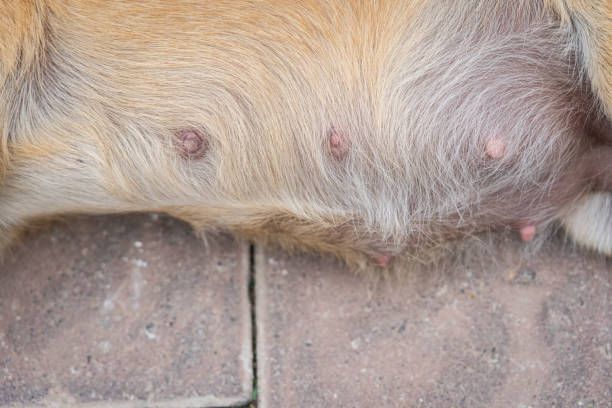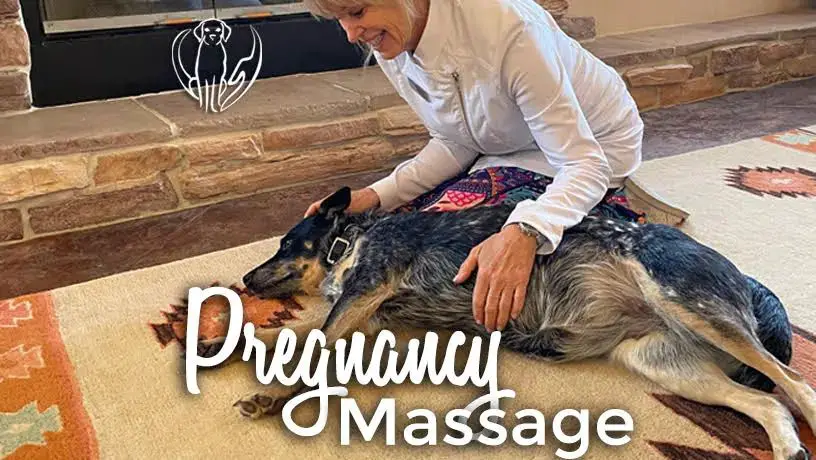Changes in the Nipples During Early Pregnancy
One of the earliest signs of pregnancy in dogs is changes to the nipples, which begin occurring around 2-3 weeks after conception. As the dog’s body prepares for nursing puppies, the nipples will start to grow in size slightly and become pinker, redder, firmer, and more erect.

The color change is caused by increased blood flow to the mammary glands. This helps the nipples transform and enlarge to get ready for producing milk. The texture also changes as the tissues swell and become engorged. The nipples will protrude more and feel full to the touch.
These early nipple changes are subtle but noticeable on close inspection. To monitor your dog’s nipples, look for a pink or dark red hue compared to the normal pale color, and gently feel that they are enlarged and firm. This is one of the first outward signs that pregnancy hormones are at work.
According to veterinarians, if you don’t notice nipple changes in the first 3 weeks after mating, the dog may not be pregnant. However, every dog is different. The timing and degree of nipple changes can vary. Tracking nipple transformations along with other symptoms can help confirm pregnancy.
Nipple Growth in Mid-Pregnancy
Around weeks 4-5 of pregnancy, a dog’s nipples will become noticeably enlarged, growing up to 2-3 times their normal size (Rexipets, 2023). This significant nipple growth occurs as the body prepares to produce milk for nursing puppies. The mammary glands begin developing and expanding underneath the nipples and areolas, pushing them outward. According to Noah’s Ark Vet, this substantial nipple enlargement is one of the most obvious visible signs that a female dog is pregnant.
Color Changes in Nipples
One of the earliest signs of pregnancy in dogs are changes to the color of the nipples and areolas. As pregnancy progresses, the nipples and areolas will darken significantly. This happens because the dog’s body is preparing for milk production and breastfeeding.
In the early stages of pregnancy, the nipples may take on a slightly rosier, pinker tone. This is from increased blood flow to the area in preparation for milk production. As the pregnancy continues into the middle stages, the nipples and areolas will become noticeably darker and more pronounced. They may turn from pink to a deep, rosy red or even a dark burgundy color.

By the last trimester of pregnancy, the nipples are often an extremely dark color, ranging from deep red to almost black in some breeds. This significant darkening happens because the dog’s mammary glands are rapidly developing in preparation for producing milk.
According to veterinarians, the darkening of the nipples is one of the most obvious physical changes in a pregnant dog (Source: https://www.southseattlevet.com/5-signs-your-dog-is-pregnant). If an unspayed female dog’s nipples become darker, larger, and more pronounced, it is a strong indicator she may be pregnant.
Nipple Firmness and Texture
One of the most noticeable changes in a pregnant dog’s nipples is that they become firmer and more swollen as the pregnancy progresses. The nipples will begin feeling harder and more rigid very early on, sometimes even before any visible enlargement occurs (https://www.southseattlevet.com/5-signs-your-dog-is-pregnant). This is due to the mammary glands preparing to produce milk. The tissue expands and becomes denser.
In addition to firmness, the texture of the nipples also changes dramatically during pregnancy. The nipples take on a bumpy, irregular surface as the mammary glands swell with milk. Whereas non-pregnant nipples are generally smooth, pregnant nipples have a knotted, lumpy feel (https://a-z-animals.com/blog/normal-dog-nipple-appearance-vs-pregnant/). The bumps may be more pronounced on some nipples than others. This uneven, bumpy texture helps the newborn puppies locate the nipples and latch on for nursing once they are born.
Owners may notice the firmness and bumpy texture as early as 3-4 weeks into the pregnancy. These tactile changes continue to progress steadily throughout gestation as the mammary glands prepare for lactation. By the final week pre-whelping, the nipples are dramatically swollen, rigid, and irregularly textured compared to their pre-pregnancy state.
Nipple Discharge
One of the most noticeable changes you may see is nipple discharge. This milky or clear fluid leaking from the nipples occurs as the mammary glands prepare to produce milk for nursing the puppies after birth. According to Chewy, you may notice this nipple discharge a few days before your dog gives birth. The milky fluid is normal and not a cause for concern. Keep the area clean by gently wiping with a warm, wet cloth to avoid irritation or infection.
Some key points about nipple discharge in pregnant dogs:
- Discharge is often milky white or clear in color.
- Leaking fluid may start up to a week before whelping.
- Gently clean nipples daily to avoid infection.
- Consult your vet if discharge has a foul odor or blood.
Monitoring your dog’s pregnant nipples for any signs of discharge will help you determine when she is close to giving birth. Contact your veterinarian if you notice any abnormal discharge from the nipples during pregnancy.
Sensitivity and Pain
As pregnancy progresses, a dog’s nipples may become more sensitive or even painful to the touch. This is due to the increased blood flow and enlargement of the mammary glands in preparation for producing milk. The heightened sensitivity helps protect the nipples and discourage the mother dog from unnecessary activity that could damage the nipples or mammary glands.
According to the South Seattle Veterinary Clinic, the nipples “may be more sensitive than usual” during pregnancy[1]. This is because the nerves in the skin become more sensitive in that area. Gentle touching that was previously tolerated may now cause discomfort or pain.
The sensitivity tends to increase as pregnancy progresses. Many dogs experience the most nipple sensitivity a few days before whelping, when the mammary glands are swollen with milk. After the puppies are born and begin nursing, the nipples may become sore and inflamed. It’s important to monitor their condition and provide pain relief if needed.
Letting your veterinarian know about any nipple sensitivity can help them best support you during your dog’s pregnancy. They may recommend protecting sore nipples by applying pet-safe nipple balm or using dog shirts between nursing sessions.
Preparing the Nipples for Nursing
As a dog’s pregnancy progresses, her mammary glands will begin preparing for milk production and nursing. Usually around 1-2 weeks before delivery, the mammary glands will start producing colostrum, the nutrient-rich “pre-milk” that contains important antibodies for newborn puppies.
Colostrum may be expressed from the nipples in late pregnancy. Gentle expression of small amounts of colostrum helps clear the mammary ducts and prepare them for nursing. However, aggressive or forceful expression should be avoided, as it can stimulate early labor. Contact your veterinarian if you have concerns about expressing colostrum before delivery.

Providing a pregnant dog with a whelping box, bedding, and secluded space helps prepare her for nursing. Keeping the mammary glands clean and monitoring nipple health is also important leading up to delivery. With proper care, the nipples can be readied to provide essential early nutrition to puppies through colostrum and milk.
Sources:
https://www.localvet.com.au/bordertown/PregnancyandLabourinDogs.aspx
https://www.abbeyvetcentregrimsby.co.uk/wp-content/uploads/2022/02/Whelping-your-first-litter.pdf
Monitoring Nipple Changes
One of the most reliable ways to detect pregnancy early on in dogs is to monitor the changes happening to the nipples. Tracking nipple growth and appearance offers a visible timeline for gauging whether or not conception has occurred. According to RexiPets, pregnant dog nipples start to enlarge and darken in color around 2-3 weeks after conception.
It’s important to establish what your dog’s nipples normally look like when not pregnant. Take note of the size, color, texture, and appearance. Then, around 3 weeks after suspected breeding, begin checking them daily for signs of enlargement and increased pigmentation. The nipples will also become more prominent and distended as they fill with mammary fluid. According to South Seattle Veterinary Hospital, if the nipples are changing dramatically, it’s a reliable indicator pregnancy has likely occurred.
Make sure to track the nipple changes week-by-week. Documenting the progression with dated photos can help monitor the timeline and have a record to show your veterinarian. Sudden nipple growth and darkening provides evidence that your dog should be examined for pregnancy. Bring up any concerns about abnormalities or unusual changes as well. Maintaining diligent observation of the nipples throughout gestation allows you to detect health issues early.
Providing Comfort
As your dog’s nipples grow and become more sensitive during pregnancy, gentle care can help provide comfort. You can clean the nipples as needed with a soft, damp cloth and warm water. Avoid vigorously scrubbing or irritating the nipples, as they can be tender. Gently pat them dry afterward. Providing a soft bedding area for your pregnant dog can also help relieve pressure on sensitive nipples.

If your dog’s nipples are swollen or irritated, you can apply a cool compress for 5-10 minutes to soothe inflammation. Wrap an ice pack or bag of frozen peas in a towel before applying to the nipples. Keep sessions brief to avoid chilling your dog. Contact your veterinarian if nipple irritation persists.
Some dogs may benefit from wearing a properly fitted maternity shirt or wrap to provide light support and protection for the nipples and mammary glands during pregnancy. Especially as the belly swells, the additional coverage can help take pressure off sensitive nipples. Just be sure any clothing allows for full airflow and movement.
Providing a quiet, comfortable place for rest, while avoiding overly rambunctious play, can also help reduce nipple irritation. Gentle massage and positive reinforcement can help your dog feel cared for as her body changes.
When to See the Vet
It’s normal for a pregnant dog’s nipples to enlarge, change color, and become more sensitive. However, you should contact your veterinarian if you notice any abnormal nipple discharge or injury.
In particular, look out for bloody nipple discharge, which can indicate a health issue. Bloody discharge is not normal and requires prompt veterinary attention. Potential causes include a bacterial infection of the mammary glands (mastitis), trauma to the nipples, or a hormone imbalance. Left untreated, it can lead to further infection or affect the unborn puppies.
You should also seek veterinary care if your dog’s nipples seem injured, inflamed, or infected. Red, swollen nipples with pus or crusty scabs point to a bacterial or fungal infection. Your vet will examine your dog and may prescribe antibiotics or antifungal medications. Proper treatment helps prevent the infection from spreading to the mammary glands or fetuses.
In addition, consult your vet if your dog seems to be in severe nipple discomfort or pain. They can recommend medications or home remedies to ease the pain and determine if an underlying condition requires treatment.
It’s important to monitor your pregnant dog’s nipples daily and contact your veterinarian at the first sign of anything unusual. Prompt care from your vet helps ensure your dog’s health during her pregnancy.
Sources:
[https://www.newportharborvets.com/services/dogs/blog/pregnant-dog-care-tips]
[https://www.webmd.com/pets/dogs/signs-dog-pregnant]
